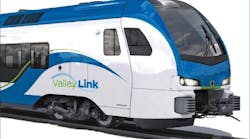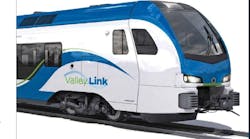Funds reallocated to Valley Link Project
The Alameda County Transportation Commission (ACTC) approved the reallocation of $400 million in Measure BB funds to the Tri-Valley – San Joaquin Valley Regional Rail Authority for the Valley Link rail project. The voter-approved county funds had originally been allocated to a proposed extension of the Bay Area Rapid Transit (BART) system from the Dublin/Pleasanton station to a new station near the Isabel Avenue interchange.
Valley Link is a two-phase passenger rail project that would deliver connectivity between BART and Altamont Commuter Express.
The Tri-Valley – San Joaquin Valley Regional Rail Authority explains the reallocation of the funds to Valley Link included several components:
• Acknowledge the rail authority as a new agency in Alameda County eligible to receive Measure BB funds from ACTC;
• Remove the BART to Livermore project and its associated $400 million from the Measure BB Transportation Expenditure Plan; and
• Add Valley Link to the expenditure plan with $400 million in Measure BB funding.
The approval followed a 45-day comment period on the proposed action. Nearly 70 letters of support were received from a wide-ranging group of government agencies, business organizations, educational institutions, labor unions and the public. The list included the cities of Livermore, Pleasanton, Dublin, San Ramon and Union City, area Chambers of Commerce, the Hacienda Business Park, the Chabot Las Positas Community College District, the Building and Construction Trades Council of Alameda County and the Innovation TriValley Leadership group to name a few.
“I am truly grateful to my ACTC colleagues who supported this action. I thank them on behalf of the 93,398 Bay Area workers who commute through the Altamont each day struggling to house their families and access jobs – and for all who receive its environmental and economic benefit. For many, transportation is more than getting from point A to point B – it’s a vehicle to opportunity and a chance to have safe and affordable choices about where they can live and work. It supports equality. It connects us. It gives many a hope for a better future,” said Alameda County Supervisor Scott Haggerty, who serves on the ACTC and is also the Regional Rail Authority’s chair.
Livermore Mayor John Marchand reflected upon the regional collaboration required to reach this point.
“Using the Measure BB funds for Valley Link brings us one step closer to keeping the promise that was made to Tri-Valley voters in 1962 and again in 2014. That is the promise of frequent, convenient rail transit through the TriValley with connections to BART and the rest of the Bay Area," said Mayor Marchand.
With this action by the ACTC, Valley Link has now identified $708 million in funding for building the rail project. This represents almost 30 percent of the of the estimated project cost.
Valley Link Executive Director Michael Tree noted, “This $400 million allocation and the other local funds identified for Valley Link will go a long way in helping us leverage state and federal funds for the project.”
Phase 1 of the proposed Valley Link project includes seven stations along 42 miles of track, connecting the existing Dublin/Pleasanton BART Station to the proposed ACE North Lathrop Station. A second phase would extend service to Stockton. Trains would be scheduled to allow for convenient transfers to BART. The first Valley Link trains could be placed into service in 2028.
Valley Link will carry 33,000 passengers a day in 2040, reducing vehicle miles travelled by 99.3 million each year, and eliminating between 33,000 to 42,000 metric tons of greenhouse gas emissions (GHG) per year depending on the vehicle technology selected. Currently, the Regional Rail Authority is considering three technologies that include two zero emission technologies; battery/electric and hydrogen.
The passenger rail project will have a significant impact on the regional economy. A recent Economic Impact Study performed by PGH Wong found that during construction Valley Link will create 22,000 jobs with an economic impact on the region of $3.5 billion. Additionally, during service, Valley Link will create 400 jobs and an economic impact of $69 million per year.





